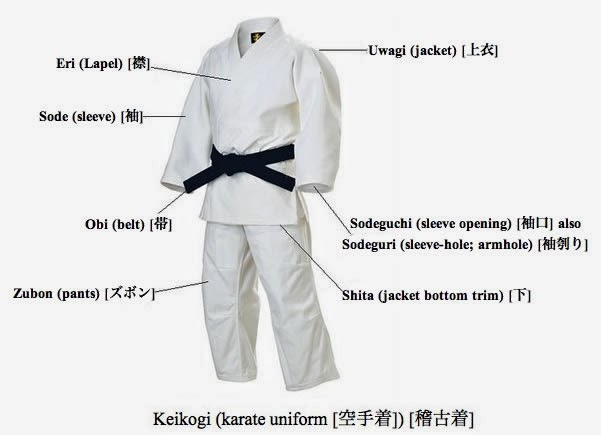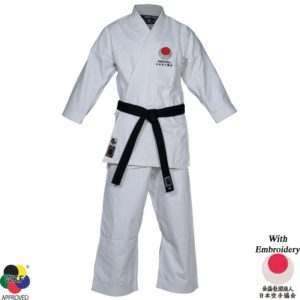What is Karate Uniform?
A Karate uniform is sometimes called by its Japanese name ‘karate do-gi’ or ‘keiko-gi’ (training clothing) or more commonly used outside of Japan is just the word ‘ gi’ (clothing/uniform) which is pronounced ‘ghee’.
It is believed the founder of judo; Jigoro Kano developed the do-gi that is similar to that used in most budo martial arts clubs today. This uniform was later modified to further fit the requirements of Karate training by the Shotokan Karate founder Gichin Funakoshi.
Over the years the karategi has developed further, notably reducing its weight and adding ties inside the jacket to help keep it closed and various styles/cuts of the material and gi shape have become popular. Before Karate became more main-stream in Japan it is believed it was practised in casual clothing in its earlier days in Okinawa.
The Martial Way uniform is generally white cotton uniforms with a cross over jacket; ‘ uwagi’ (upper uniform) that forms a v-neck shape when closed and has matching white ‘shitabaki’ or ‘ zubon’ (pants), they are worn with a ‘ obi’ (belt) corresponding to the persons grading rank.

The Jacket (Uwagi)
The 'uwagi' should allow room to be able to punch and rotate the arms and twist the waist without restriction. The jacket should be long enough to pass the waist, there should be enough (suso) 'jacket skirt' material hanging under the belt so that it does not easily ride up and become un-tucked over the belt when performing standard movements, 4 to 8 inches below the belt is usually standard.
The (sodeguchi) 'sleeve cuffs’ should finish before or at the wrists (some people prefer them shorter) and not be long enough to pass over the hands. The left side of the jacket should be on top/outside of the right side of the jacket so that the (hidari-mae-eri) 'front left lapel’ runs from the top left to the bottom right. Supposedly wearing the (migi-mae-eri) 'right front lapel' over the left signifies death in Japanese culture so best to get that 'right' (left).
The Pants (Zubon)
The 'zubon' needs to be designed in a way to allow maximum leg movement/freedom as Karate contains kicks and stances that are very diverse. This is usually achieved by the pants having a wider cut and extra joining material under the groin area. When kicking, correct fitting pants should not cause restrictions around the thigh or groin area of the pants. The (suso-guchi) 'bottom of the pants or pant cuff' should finish just above the feet (again some people prefer them shorter) and not be long enough to be resting on the floor so that there is no chance of tripping on them or catching any part of the foot inside them, 3-5 inches smaller than leg length is standard.
Most traditional pants will have a high level of adjustment around the waist from a draw string. Elastic waist band pants are also available with some gi’s, these are more commonly worn by beginners and children but not exclusively.
The Belt (Obi)
It is not uncommon for karategi’s to not include a ‘obi’ (belt), in fact most higher quality karategi’s usually do not, beginner gi’s sometimes include a standard white belt. I won’t go in to details about belt types or how to tie a belt in this article but just make sure the belt is long enough to wrap around twice and after tied should hang down at the front ending somewhere close to the bottom of the jacket, belts that hang too far down not only look daft but get in the way of techniques, I have even known beginners to get flicked in the eye by the end of their own belt when kicking, this should obviously be avoided by buying the correct size belt and tying it correctly.
What about the sizing?
Choosing the correct size gi seems to be one of the most problematic factors when purchasing a gi. Whilst there can be slight differences in sizes from one brand to another, you should be able to get somewhere close by following these steps. From experience some brands seem to be more generous on sizing than others, this can also become more apparent if buying the wrong type/cut of gi.
Karategi’s usually have two elements for the sizing, for example size 4 – 170cm.
However, just because you may be a size 4 in one karategi you may be a size 5 in a different brand and type of gi. This is most notable with karategi’s due to there being differences sometimes with Japanese and European gi’s/manufactures. For example size 4 in a Japanese manufactured gi can sometimes be 160cm where in a European gi it is usually 170cm.
To best avoid this I would advise to always look at the ‘measurement’ in cm and select the size from that rather than the single digit ‘size’ for example pick one that states 170cm rather than just size 4.
Some suppliers will have an age range estimate for the kids gi sizes, although maybe useful for a general guide I would advise paying more attention to the height and measurement size chart than this.
The other main point to remember when picking the correct size in cm is what the measurement is actually for. The measurement given on the gi size in cm corresponds to a person’s height in cm not the actual gi length.
For example if you are 168cm tall and the gi size is 170cm, then that is the gi size that should fit you e.g. size 4 - ‘170cm’.
There are however other factors to consider, if you have a much larger or smaller than average build you may need to go up or down a size (this is usually easier when half sizes are available e.g. 175cm). Some karategi's will also have a size chart that details the individual measurements for each size of the gi for example you can see the inside/outside arm and leg length and jacket length etc of a 170cm gi.
Karategi sizes usually range from:
- Kid sizes: 000/110cm to 2/150cm
- Adult sizes: 3/160cm to 7/200cm
| Karategi sizes | cm | feet |
|---|---|---|
| 000 | 110 | 3" 6' to 3" 7' |
| 00 | 120 | 3" 8' to 4" 0' |
| 0 | 130 | 4" 1' to 4" 4' |
| 1 | 140 | 4" 5' to 4" 8' |
| 2 | 150 | 4" 8' to 5" 1' |
| 3 | 160 | 5" 1' to 5" 5' |
| 4 | 170 | 5" 5' to 5" 9' |
| 5 | 180 | 5" 10' to 6" 0' |
| 6 | 190 | 6" 1' to 6" 3' |
| 7 | 200 | 6" 4' to 6" 7' |
Shrinkage is also something to be considered. As explained below pure cotton gi’s do shrink, how much depends on the material, weave/density, if it's pre-shrunk and how you wash/dry your gi.
Gi Type & Cut
Over the years the karategi has developed, there are now different types of karategi available that better suit different styles/types of training, competition, grade, build and personal/club preference.
There are two (or four depending how you split them) main karategi cuts to be aware of. These are; Japanese and European cut. There are also Kata and Kumite cuts, although a kata gi can be used for sparring and a kumite gi for kata these cuts are more for personal preference or competition and aesthetic reasons.
The difference in cut may be slightly favourable in terms of freedom of movement for either Kata or Kumite training but as most Karate training consists of both these idead a good karategi should be generally ok for all aspects of Karate training. Usually a Kata gi is closer in comparison to a Japanese cut gi and a Kumite gi closer to a European cut. Kumite gi’s are usually lighter than kata gi’s.
The Japanese cut features shorter sleeves and pants with a longer jacket, the kata gi is almost an exaggerated version of this. The European and Kumite cuts are opposite to this and usually have longer sleeves and pants.
Gi Material
New material and weave combinations are constantly developing and being used for various karategi’s. The main two materials used for karategi’s are cotton and polyester. There are also different weaves such as single weave (lighter and cooler) and double weave (heavier and thicker) to name the main two. Each material/weave has different advantages and disadvantages but ultimately it comes down to personal preference.
Cotton used to usually be preferred to the poly-cotton or polyester gi’s, usually the cotton gi’s are more expensive. Cotton gi’s do shrink more than poly-cotton gi’s, but pre-shrunk cotton gi’s are available. There are also now gi’s that have a material from a polyester core wrapped with cotton that feels similar to a cotton gi but is more durable and lighter.
Some gi’s can come in a brushed cotton or a none brushed or stiffer canvas material. Brushed cotton is usually lighter in weight and more comfortable. Canvas gi’s are usually more durable and can give a crisper snap to your techniques.
Gi Weight
Karategi weights from lightweight to heavyweight are usually split up into the following categories:
Lightweight: 6oz to 8oz usually used by beginners and children. Can be good for agility but material can sometimes be a little thin.
Middleweight/light-heavy: 10oz to 12oz these are more durable than the lightweight gi’s and are often used more by intermediate level students or advanced students that prefer a slightly lighter Kumite type of gi.
Heavyweight: 14oz to 16oz these gi’s are made from a heavy drill cotton or canvas or double weave cotton. These are generally preferred by more advanced students, usually these are of a higher quality and cost more due to the material used however they are a lot more durable and should last a long time.

WKF approved karategi with JKA embroidery (front)

WKF approved karategi with JKA embroidery (back)




